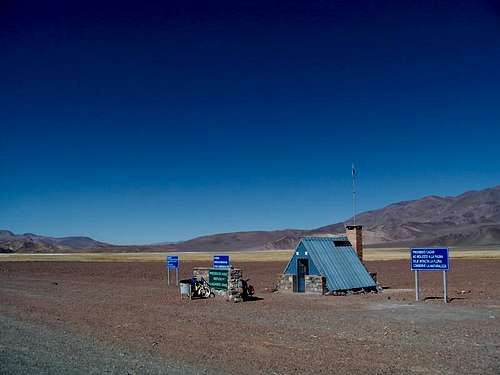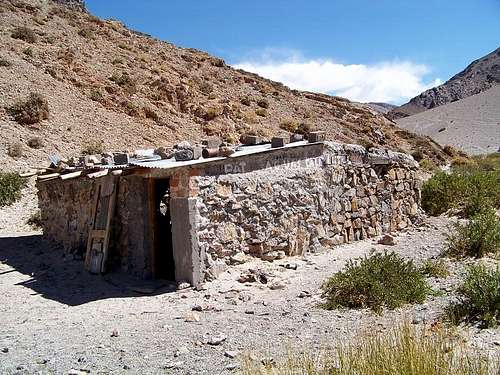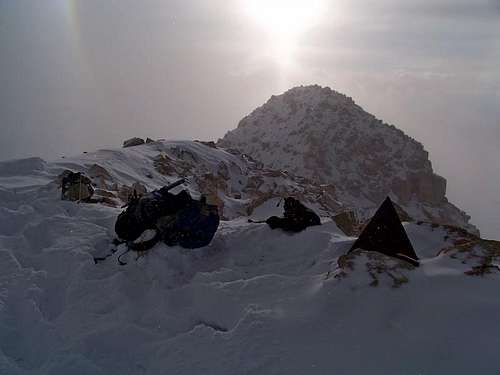|
|
Route |
|---|---|
|
|
27.10611°S / 68.53944°W |
|
|
Mountaineering |
|
|
Expedition |
|
|
F |
|
|
Disclaimer
I climbed this route on 12th of April 2009. I post it as a new route because I couldn’t find any information about anyone climbing that line before that although it seems impossible for me that such an obvious formation hadn’t been climbed yet. If you know anything about potential precedent climbs, please contact me in order to update this page.Approach
The approach is the same as for Mike Dorse Direct route. If you want to climb Ojos del Salado from the Argentinian side, you need to get to Cazadero Grande, which is a place on the international road no. 40 leading from Fiambala, Argentina to Copiapo, Chile. Cazadero Grande is 113 km from Fiambala and the hike towards the mountain starts near the shelter no. 3 next to the road.If you have a good 4x4 car you can go a few kilometers further to the west right to the end of the Rio Cazadero valley. There’s a small hut by the stream if one wishes to spend a night there on their way up or back.
There are two options for the hike to El Arenal which is a place for the base camp under Ojos del Salado. Both of them go up the valley until they reach Aguas Calientes, which is the last place where you can find running water. From there on you need to rely on melting snow mostly. It takes about one day to get to Aguas Calientes.
Here you need to decide if you follow the Cazadero Valley which means going forward in the direction of Cerro Nacimiento or turn right to go through the Portezuelo Negro, which is a pass right next to El Arenal. I can’t really tell much difference between the two options, both of them require about the same amount of time, but the Cazadero option crosses a smaller pass. This part is probably going to take at least one full day more. It’s really helpful to get some GPS waypoints for this leg and you can find those for the Portezuelo posted by Corax on the main Ojos del Salado page. Visit the Museo de los Seismiles when in Fiambala, because you can see some good maps of the area there.
Route Description
The route follows the Chilean-Argentinian national border (I guess…), which means it’s to the right from Mike Dorse Direct. It’s easy to find it, because it’s the first big, wide ridge to the right from the glaciers (see the small picture on the top of the page).
First you need to climb the lower, flat part of the ridge on top of which you will find numerous small lakes created by melting snow. Here’s where the ridge gets steeper and requires some long but easy scrambling. It takes a few hours to negotiate this part and the ridge ends up with a spectacular crater.
Now you cross a small saddle between the crater and the final slope that leads you to the summit, but it’s still 400 vertical meters to the top. You need to find your way between some steeper rocky sections first, but then it gets easier until the final summit pyramid, where it gets a bit steeper again.
You finish on the Argentinian summit, so if you want to climb the Chilean one too, you need to cross the saddle between them, which requires some easy climbing. You can find a description of this section on the Normal Route site.
All in all, the route is a hike up with some scrambling sections and is a good alternative for the MDD if the snow on the glacier seems to be soft. It’s easier to climb up the Ruta Varsoviana than to down climb it, so consider choosing it for your way up to the summit and coming back by the MDD or the Normal Argentinian Route, which allows you to see two routes in a single push.
Essential Gear
Bring crampons and an ice axe for the glacier but you probably won’t need them on the route itself because it’s mostly rocky. No climbing gear is required unless you don’t feel confident about climbing the Chilean summit. Trekking poles are always very useful.Name
The name comes from a Polish figurative expression. Among the neighbourhoods in Warsaw there are Wola and Ochota, both of which can be literally (although mistakenly) translated as “will” or “desire”, so the Warsaw Route (or Ruta Varsoviana in Spanish) figuratively means that you can go wherever your free will leads you. And that’s exactly the way you can climb most summits in Puna :-)Besides there is already a Polish Route on the mountain - the line of the first ascent in 1937 by Wojsznis and Szczepanski.







